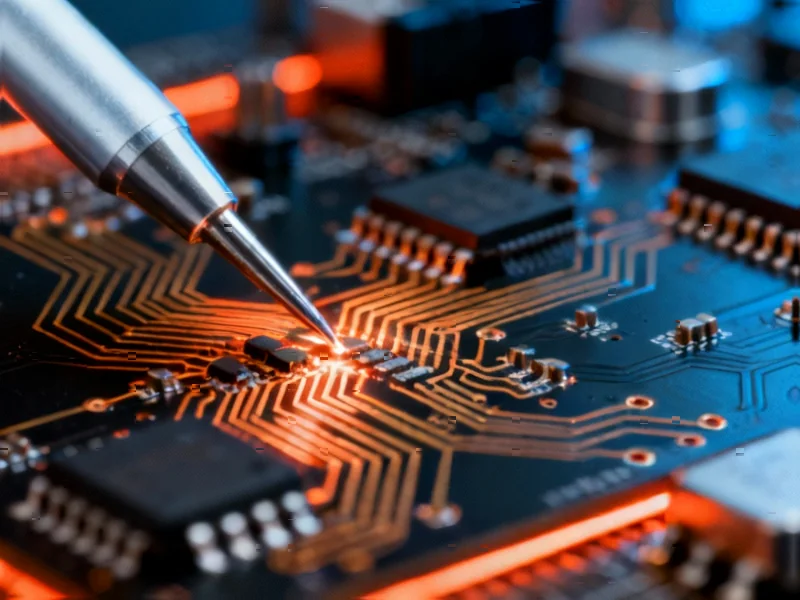Revolutionary Sensor Design Overcomes Flexibility-Sensitivity Tradeoff
Researchers have reportedly developed a breakthrough flexible temperature sensor that maintains high sensitivity while withstanding significant deformation, according to recent findings published in Microsystems & Nanoengineering. Sources indicate the innovation solves a longstanding paradoxical challenge in flexible electronics where increased flexibility typically compromises measurement accuracy and stability.
Table of Contents
- Revolutionary Sensor Design Overcomes Flexibility-Sensitivity Tradeoff
- Structural Innovation: The Peano Architecture Advantage
- Material Science Breakthrough: MWCNT Reinforcement
- Advanced Manufacturing and Surface Engineering
- Exceptional Performance Under Deformation
- Implications and Future Applications
Structural Innovation: The Peano Architecture Advantage
The sensor’s thermo-electrode employs a Peano structure with a 270° arc angle instead of traditional linear designs, analysts suggest. Mechanical simulations comparing four different structures—linear and Peano variants with 90°, 180°, and 270° arc angles—revealed the Peano configuration significantly reduces internal stress during deformation. The report states that under identical conditions, the 270° Peano structure reduced maximum internal stress to 69.03% compared to conventional linear electrodes.
According to the research team, this structural optimization substantially improves the sensor’s safety performance during operation while maintaining identical thermoelectric properties to traditional designs. Simulation results showed all structures produced equivalent temperature fields and output thermal electromotive force, with maximum output reaching 51.2 mV at a 340°C temperature difference.
Material Science Breakthrough: MWCNT Reinforcement
The sensor incorporates multi-walled carbon nanotubes (MWCNTs) as connecting lines between indium oxide (In2O3) powder particles, creating a powder-fiber staggered adhesion microstructure. Reports indicate MWCNTs were selected for their exceptional length-diameter aspect ratios (approximately 25 nm diameter and 15 μm length), high strength, elasticity, and stability at temperatures below 400°C.
Experimental results showed that adding MWCNTs significantly enhanced deformation resistance while moderately reducing thermoelectric sensitivity. As MWCNT content increased from 0.00g to 0.10g, the average Seebeck coefficient decreased from 195.5 μV/°C to 76.0 μV/°C at 200°C, while electrical conductivity improved substantially. The research team ultimately selected 0.08g MWCNTs as the optimal balance between sensitivity and mechanical robustness.
Advanced Manufacturing and Surface Engineering
Before sensor fabrication, researchers employed inductively coupled plasma (ICP) technology to modify the polyimide substrate surface. The report states that surface roughness increased dramatically from 26 nm to 173 nm after 1200 seconds of ICP treatment, significantly improving paste adhesion during the screen-printing process.
The manufacturing process featured a co-conformal preparation method where the flexible substrate was adhered to curved surfaces during electrode deposition. This approach, according to sources, pre-stresses the thermo-electrodes to minimize performance degradation during actual deformation. The screen-printing process involved multiple coating cycles with intermediate curing at 120°C for 10 minutes, followed by final heat treatment at 360°C for 90 minutes.
Exceptional Performance Under Deformation
Bending tests conducted using concentric axis methodology demonstrated remarkable stability for the optimized design. Analysis revealed that when MWCNT content exceeded 0.08g, the thermal electromotive force and Seebeck coefficient remained unaffected by bending deformation. For the selected InO-0.08gMWCNTs material, maximum voltage variation was only 6.5% during testing.
Researchers noted that the thermoelectric properties became virtually independent of the attached surface shape, a critical advancement for practical applications. Batch consistency testing showed maximum precision error between two production batches of just 2.32%, indicating high manufacturing reproducibility.
Implications and Future Applications
This development in flexible sensing technology potentially enables reliable temperature monitoring in applications requiring significant mechanical deformation, including wearable electronics, biomedical devices, and industrial monitoring systems. The successful integration of structural design, material science, and advanced manufacturing approaches demonstrates a comprehensive solution to the flexibility-stability challenge that has limited previous flexible sensor technologies.
The research team’s methodology of combining computational simulation with experimental validation provides a robust framework for future sensor development, according to analysts familiar with the technology. The reported consistency across production batches suggests the approach is suitable for scalable manufacturing, potentially enabling broader adoption in commercial applications.
Related Articles You May Find Interesting
- Digital Health’s Survival Strategy: Why 2025’s M&A Wave Signals Industry Transfo
- AWS Trails in AI Cloud Competition But Recovery Signs Emerge, Analysts Report
- How Visa’s Billion-Dollar AI Defense Is Reshaping Global Fraud Prevention
- AI’s Promise for Developing Economies Faces Infrastructure and Literacy Hurdles
- Meta’s Strategic AI Pivot: High-Profile Talent Retained as 600 Jobs Cut in Super
References
- http://en.wikipedia.org/wiki/Substrate_(chemistry)
- http://en.wikipedia.org/wiki/Electromotive_force
- http://en.wikipedia.org/wiki/Thermoelectric_effect
- http://en.wikipedia.org/wiki/Polyimide
- http://en.wikipedia.org/wiki/Tension_(physics)
This article aggregates information from publicly available sources. All trademarks and copyrights belong to their respective owners.
Note: Featured image is for illustrative purposes only and does not represent any specific product, service, or entity mentioned in this article.



